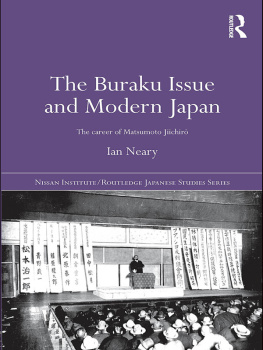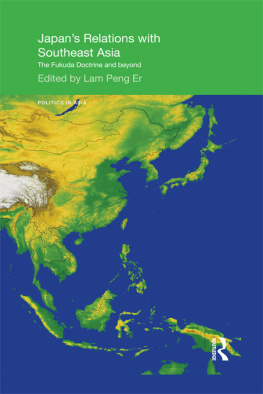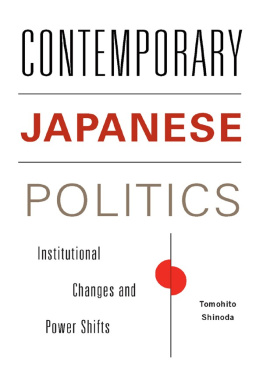
The State and Politics in Japan
Second Edition
IAN NEARY
polity
Copyright Ian Neary 2019
The right of Ian Neary to be identified as Author of this Work has been asserted in accordance with the UK Copyright, Designs and Patents Act 1988.
First published in 2019 by Polity Press
Polity Press
65 Bridge Street
Cambridge CB2 1UR, UK
Polity Press
101 Station Landing
Suite 300
Medford, MA 02155, USA
All rights reserved. Except for the quotation of short passages for the purpose of criticism and review, no part of this publication may be reproduced, stored in a retrieval system or transmitted, in any form or by any means, electronic, mechanical, photocopying, recording or otherwise, without the prior permission of the publisher.
ISBN-13: 978-1-5095-3585-9
Library of Congress Cataloging-in-Publication Data
Names: Neary, Ian, author.
Title: The state and politics in Japan / Ian Neary.
Description: Cambridge ; Medford, MA : Polity Press, [2019] | Includes bibliographical references and index.
Identifiers: LCCN 2018041106 (print) | LCCN 2018046281 (ebook) | ISBN 9781509535859 (Epub) | ISBN 9780745660479 (hardback) | ISBN 9780745660486 (pbk.)
Subjects: LCSH: Japan--Politics and government--1868
Classification: LCC DS881.9 (ebook) | LCC DS881.9 .N43 2019 (print) | DDC 320.952--dc23
LC record available at https://lccn.loc.gov/2018041106 Typeset in 10 on 13pt Swift by
The publisher has used its best endeavours to ensure that the URLs for external websites referred to in this book are correct and active at the time of going to press. However, the publisher has no responsibility for the websites and can make no guarantee that a site will remain live or that the content is or will remain appropriate.
Every effort has been made to trace all copyright holders, but if any have been overlooked the publisher will be pleased to include any necessary credits in any subsequent reprint or edition.
For further information on Polity, visit our website: politybooks.com
Map of Japan

Introduction
The purpose of this book is straightforward: to provide an easily accessible account of Japanese politics for a student who is encountering it for the first time or the general reader who, for whatever reason, needs to know how it works. The most notable feature of contemporary Japanese politics is the way it has been dominated by Abe Shinz since he achieved power for the second time in the closing days of 2012. At the time of writing, he has been in post for over five years and is likely to remain prime minister until 2021. Even if this does not happen and everything we know about the volatility of political life advises caution it is still reasonable to ask what difference he has made to Japanese politics. The main argument that I want to develop is that he has made a substantial difference, and I will be concerned to explain both how and why.
However, there is a tension between developing this argument and producing a comprehensive overview. Abe has paid little attention to local government or environmental issues or even, until recently, welfare policy, but that would not be a good reason to omit them from this account. So, in addition to the main theme, we will also be interested to explore the role of leaders and leadership, the nature of party politics, the extent of bureaucratic control, Japans engagement with its global context, and the general features of policy process and content in selected areas always asking what influence Abe has had on each of these areas.
Each chapter summarises the existing literature well aware that there is much more that could be said. With this in mind, there are references within the text to some of the sources that this writer has found useful and that the reader may wish to consult in order to extend his or her knowledge of specific topics. There is also a great deal of information and data available online, particularly on the websites of the relevant ministries. Most readers will be more proficient at accessing such data than the present writer. What I hope to do in the chapters that follow is to provide a context that will enable a nuanced understanding of that detail.
We begin with a summary of the emergence of a modern political system during the nineteenth century that ends with the political processes that were in place at the point of defeat in 1945. The mainly US occupation of Japan took democratisation as one of its main themes, so explains how its reforms were implemented and with what success. Then follow two chapters that provide an overview of the political narrative from the mid-1950s up to the present day 2018. Next we turn to look at how the structures and arenas of politics changed over the same period and consider how Abe has tried to mould them so that they are better able to deliver his policy priorities. In the final section, we consider how policy has changed and is changing in five areas: foreign and defence policy, industrial policy, environment policy, welfare policy and human rights policy. Again, our principal focus will be on what Abe has done and with what success.
Japan is no longer the shining example of how rapid economic development can be achieved alongside the development of liberal democratic practice. Firstly, neighbouring states in East Asia, notably South Korea and Taiwan, have adopted political reforms that include regular and genuinely competitive elections and a commitment to democratic practice and human rights while maintaining their rapid economic growth. Meanwhile, in China, the reforms of the 1980s initiated and then sustained rapid economic growth, although without any indication so far that this will lead to political liberalisation. This has made Japanese politics a less obvious choice for students of political science concerned to extend their horizons, or for students of Japan interested in its political structures. However, Japan is being forced to address social challenges in domestic policy that will soon be shared by most developed countries. The most important of these is the rapid ageing of the population accompanied by a declining birth-rate. Abe is committed to making Japan a pioneer in establishing a social model for other countries. This is not simply a question of redesigning social policy but also of making fundamental changes to industrial policy, agriculture and working practices. During the twentieth century, Japanese politicians regarded their role as being to ensure that their country caught up with the rest of the advanced world. That task is now complete. Politicians in Japan today find themselves among the first to have to deal with new problems ranging from rapid demographic change to the emergence of crypto-currencies and the social application of artificial intelligence. This book will not try to investigate what decisions are being made in these areas in most cases it is too soon to do so. However, by getting a secure grasp of the fundamental patterns that exist within the Japanese political system, readers will be better able to assess for themselves the strengths and weaknesses of the solutions being proposed.
Japanese Politics from Meiji to Early Shwa
Japan in the middle of the nineteenth century faced a series of crises generated both from within the country and from outside. Ultimately unable to devise effective policies to deal with either set of problems, the decentralised government structured around the Tokugawa Shogun was replaced by a new regime led, in theory at least, by the sixteen-year-old Emperor Mutsuhito, whose reign beginning in 1868 was designated Meiji, enlightened rule. This put the emperor back at the centre of the political system and was known as the Meiji restoration because it purported to be restoring imperial rule (
Next page













